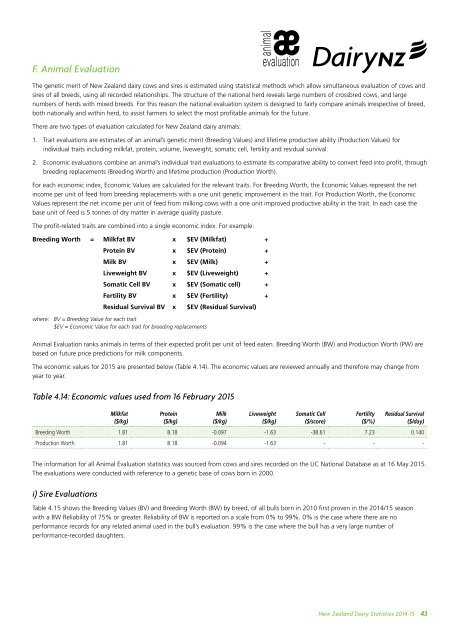New Zealand Dairy Statistics 2014-15
DAIRY%20STATISTICS%202014-15-WEB-6%20NOV%2015
DAIRY%20STATISTICS%202014-15-WEB-6%20NOV%2015
You also want an ePaper? Increase the reach of your titles
YUMPU automatically turns print PDFs into web optimized ePapers that Google loves.
F. Animal Evaluation<br />
The genetic merit of <strong>New</strong> <strong>Zealand</strong> dairy cows and sires is estimated using statistical methods which allow simultaneous evaluation of cows and<br />
sires of all breeds, using all recorded relationships. The structure of the national herd reveals large numbers of crossbred cows, and large<br />
numbers of herds with mixed breeds. For this reason the national evaluation system is designed to fairly compare animals irrespective of breed,<br />
both nationally and within herd, to assist farmers to select the most profitable animals for the future.<br />
There are two types of evaluation calculated for <strong>New</strong> <strong>Zealand</strong> dairy animals:<br />
1. Trait evaluations are estimates of an animal’s genetic merit (Breeding Values) and lifetime productive ability (Production Values) for<br />
individual traits including milkfat, protein, volume, liveweight, somatic cell, fertility and residual survival.<br />
2. Economic evaluations combine an animal’s individual trait evaluations to estimate its comparative ability to convert feed into profit, through<br />
breeding replacements (Breeding Worth) and lifetime production (Production Worth).<br />
For each economic index, Economic Values are calculated for the relevant traits. For Breeding Worth, the Economic Values represent the net<br />
income per unit of feed from breeding replacements with a one unit genetic improvement in the trait. For Production Worth, the Economic<br />
Values represent the net income per unit of feed from milking cows with a one unit improved productive ability in the trait. In each case the<br />
base unit of feed is 5 tonnes of dry matter in average quality pasture.<br />
The profit-related traits are combined into a single economic index. For example:<br />
Breeding Worth = Milkfat BV x $EV (Milkfat) +<br />
Protein BV x $EV (Protein) +<br />
Milk BV x $EV (Milk) +<br />
Liveweight BV x $EV (Liveweight) +<br />
Somatic Cell BV x $EV (Somatic cell) +<br />
Fertility BV x $EV (Fertility) +<br />
Residual Survival BV x $EV (Residual Survival)<br />
where: BV = Breeding Value for each trait<br />
$EV = Economic Value for each trait for breeding replacements<br />
Animal Evaluation ranks animals in terms of their expected profit per unit of feed eaten. Breeding Worth (BW) and Production Worth (PW) are<br />
based on future price predictions for milk components.<br />
The economic values for 20<strong>15</strong> are presented below (Table 4.14). The economic values are reviewed annually and therefore may change from<br />
year to year.<br />
Table 4.14: Economic values used from 16 February 20<strong>15</strong><br />
Milkfat<br />
($/kg)<br />
Protein<br />
($/kg)<br />
Milk<br />
($/kg)<br />
Liveweight<br />
($/kg)<br />
Somatic Cell<br />
($/score)<br />
Fertility<br />
($/%)<br />
Residual Survival<br />
($/day)<br />
Breeding Worth 1.81 8.18 -0.097 -1.63 -38.61 7.23 0.140<br />
Production Worth 1.81 8.18 -0.094 -1.63 - - -<br />
The information for all Animal Evaluation statistics was sourced from cows and sires recorded on the LIC National Database as at 16 May 20<strong>15</strong>.<br />
The evaluations were conducted with reference to a genetic base of cows born in 2000.<br />
i) Sire Evaluations<br />
Table 4.<strong>15</strong> shows the Breeding Values (BV) and Breeding Worth (BW) by breed, of all bulls born in 2010 first proven in the <strong>2014</strong>/<strong>15</strong> season<br />
with a BW Reliability of 75% or greater. Reliability of BW is reported on a scale from 0% to 99%. 0% is the case where there are no<br />
performance records for any related animal used in the bull’s evaluation. 99% is the case where the bull has a very large number of<br />
performance-recorded daughters.<br />
<strong>New</strong> <strong>Zealand</strong> <strong>Dairy</strong> <strong>Statistics</strong> <strong>2014</strong>-<strong>15</strong> 43


